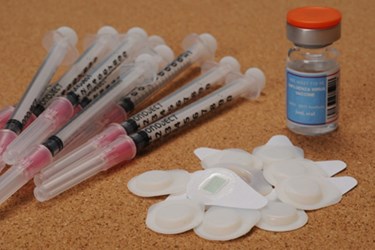Self-Administered Microneedle Patches May Facilitate Flu Vaccinations
By Joel Lindsey

A team of researchers from Georgia Tech, Emory University, and the Centers for Disease Control and Prevention (CDC) are developing a microneedle patch that may make flu vaccinations easier, cheaper, and less painful.
The patches consist of an arrangement of 50 microscopic needles approximately as long as the thickness of a few hairs. Designed for self-administration, a user presses the patch onto his or her forearm where the needles painlessly carry flu vaccine into the outer layers of skin, a news article published on Georgia Tech's website reported.
In a study published recently in the journal Vaccine, researchers reported high rates of successful self-administration and positive patient feedback among a test group of nearly 100 people.
"We found that everyone was capable of administering a microneedle patch appropriately, though not everyone did on the first try," said Mike Prausnitz, Regent's professor in the School of Chemical and Biomolecular Engineering at Georgia Tech, and an author of the study. "Our dream is that each year there would be flu vaccine patches available in stores or sent by mail for people to self-administer."
Prausnitz added, "We want to get more people vaccinated, and we want to relieve health care professionals from the burden of giving these millions of vaccinations."
During the experiment, researchers interviewed test subjects about how painful administering the patch was and about their vaccination preferences.
On a scale of increasing pain from 1 to 100, the patch received an average rating of 1.5, while hypodermic needles received an average rating of 15. And, when the microneedle patch was given as a vaccination option, the rate of people willing to receive vaccination rose from 46 percent to 65 percent.
"In addition to the preference for the vaccine patch, we found that a large majority of the people willing to be vaccinated would choose to self-administer the vaccine," said James Norman, the study's first author.
Researchers argue that the microneedle patch could ultimately lead to significant reductions in healthcare costs by making it easier and less expensive to store, ship, and administer vaccinations.
By making flu vaccinations more widely available and appealing, researchers claim the patch could cut back on the number of flu-related hospitalizations and deaths in the U.S.
According to Paula Frew, an assistant professor at the Emory University School of Medicine and a co-author of the study, if the trends of the study hold true for the entire population, it "would have a tremendous impact on preventing disease and the cost associated with both influenza and the vaccination process."
Researchers plan to move the microneedle patch into clinical studies in the near future, and hope that patches could be publicly available within five years.
Image Credit: Georgia Institute of Technology: http://goo.gl/8wtZEq
